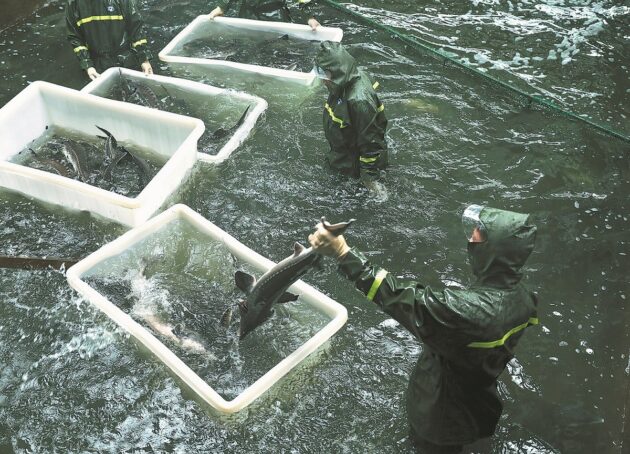
Fish farming on dry land nets multiple catches
To support his family of five, Deng Zhongzheng used to spend day and night on the Qingjiang River tending to his floating fish farm. Braving wind and rain, he could hardly spare a single day away from his 30 cages of sturgeons.
If business was good, he could make more than 100,000 yuan ($13,800) a year, but if it was bad, floods could rob him of his entire school of fish.
However, Deng’s life living at the mercy of the weather changed in 2016 after the government in Yidu, Hubei province, ordered all floating fish farms to operate onshore.
The results of the government’s decision have been twofold — fish farmers’ incomes have been secured, and the Qingjiang River, no longer a pawn of industry, has gotten a lot cleaner.
As the Qingjiang is a major tributary to the Yangtze, Asia’s longest watercourse has stood to benefit, too.
Eights years prior, the development of fish farming in the Qingjiang had been disorderly, with fish cages covering most of the water surface, leaving only a narrow channel, said Deng.
Farmers kept increasing the use of fodder in an attempt to boost their incomes, which resulted in heavy pollution. “Some parts of the river were black, and others became reddish with a lot of rubbish and dead fish,” he said.
According to the Yidu government, people started to farm sturgeon in the area in the 1990s, and 555 households were engaged in the business as of 2016. At that time, sturgeon cages in Yidu occupied a total water surface area of almost 8.65 square kilometers, and it contributed to 30 percent of the country’s total sturgeon production.
The farming activity led to severe eutrophication in the Qingjiang, with the quality of the water in some areas falling below Grade V, the lowest rating in the country’s five-tier quality system for surface water.
Following the leadership’s instructions in 2016 calling for concerted efforts to protect the Yangtze and stop overdevelopment, the local authority decided to remove all fish cages in the Qingjiang and another watercourse named Yuyang, said Wang Desheng, head of Yidu’s aquaculture service center.
The government raised almost 300 million yuan to support the work, and the operation was completed in 2017, he noted.
The removal of the cages didn’t mark the end of the industry in Yidu, but the beginning of an endeavor to upgrade it to make it green, with three sturgeon aquaculture bases built onshore.
Deng and Liu Zhongxing, who once also ran a sturgeon farm on the Qiangjiang, now work at a base dubbed “sturgeon valley”. Covering an area of over 120,000 square meters, the base is home to more than a million sturgeon, and has provided stable incomes to farmers.
On the river, things were never stable.
Liu recalled a time in 2015 on the river when he lost all his fish to a sudden deluge. All 10 of his cages and a potential income of 500,000 yuan were washed away.
“With elderly parents and a daughter to take care of, I was under great economic pressure back then,” he said.
The government arranged a job for Liu, 40, in the “sturgeon valley” after learning about his difficulty.
The industrial aquaculture in the base is much more environmentally and cost-friendly than the way he used to raise the sturgeons, said Liu.
Supported by a strong scientific research team, some of which are from Huazhong Agriculture University in Wuhan, Hubei province, he said the base now only needs to feed 1.2 kilograms of fodder to ensure the increase of 1 kg in the weight of the fish.
As the head of one of the company’s sturgeon farms, Liu can make up to 200,000 yuan from his job annually. Moreover, he can enjoy much more leisure time.
Wang, head of the aquaculture service center, said while the sturgeon industry in Yidu has grown significantly, there has also been a great improvement in the aquatic environment of the Qingjiang River since the removal of the fish cages.
Currently, 100 metric tons of sturgeon caviar is produced in Yidu every year, twice as much as in 2016, he said. The annual turnover of the product stands at 200 to 300 million yuan.
“The quality of water in the section of the Qingjiang in Yidu has been kept above Grade II,” he said, adding that rare and endangered bird species such as the Chinese merganser and black stork have shown up again.
For more visit China Daily
For subscriptions on news from China Daily, or inquiries, please contact China Daily Africa Ltd on +254 733 566 499 or write to enquiries@chinadailyafrica.com
